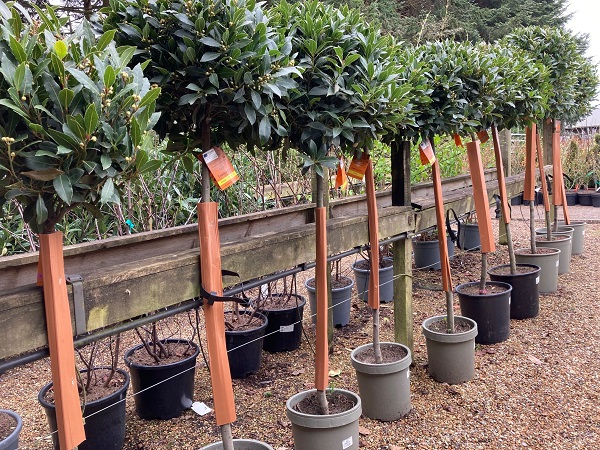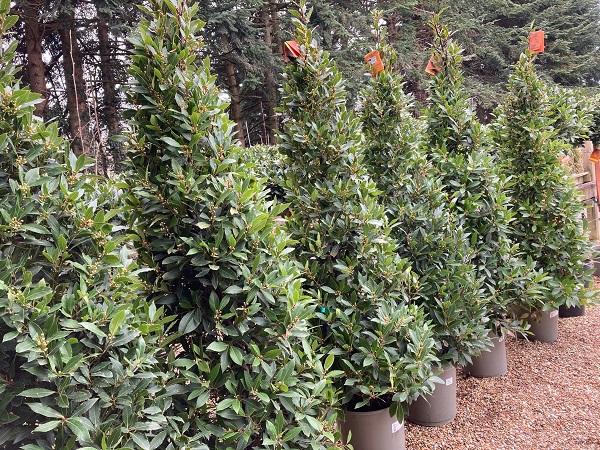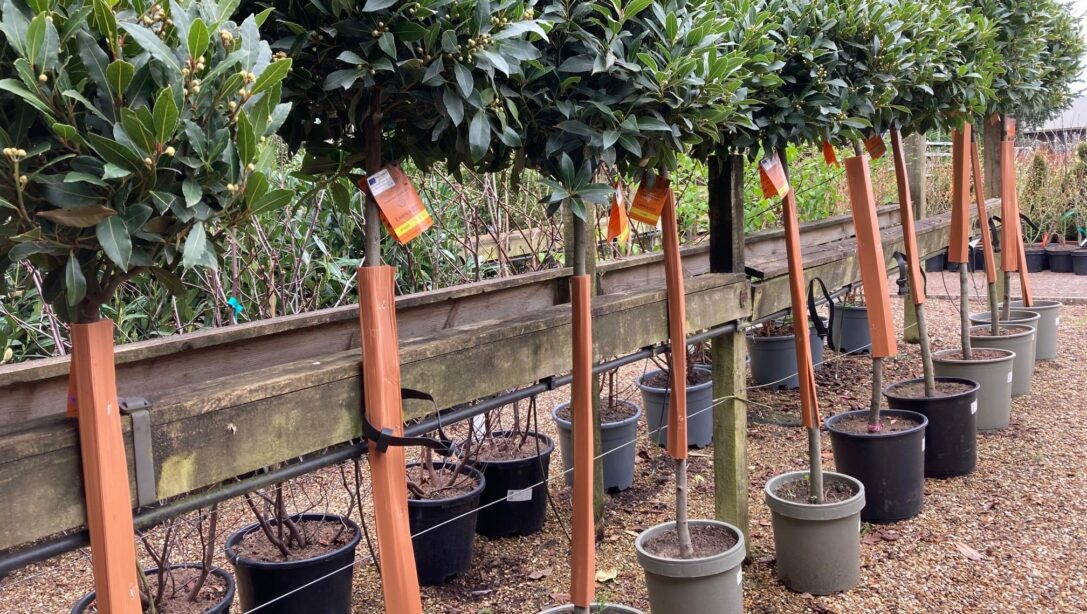Shaped bay trees are very slow-growing, but over time they can reach a significant size — more than 10 metres in height and 5 metres in width. For those who prefer their tree to remain smaller, topiary bays are extremely popular. These are usually grown in containers, positioned around front doors to frame an entrance or on patios as an architectural statement. The most frequently found forms are lollipop-shaped ‘standard’ bays. Alternatively, there are pyramid-shaped trees, akin to a softer version of a Christmas tree.
Position in full sun or partial shade and enjoy the rich green of the leaves, the appealing structure of their form and the aromatic scent from the leaves.
View our collection of plantsShaped Bay Tree | Laurus nobilis Varieties
Laurus nobilis, perhaps better known as bay or bay laurel, is a hardy, evergreen shrub that is loved as much for the wonderful flavour the leaves add to recipes as for its appearance in the garden.
There are several bay tree shapes available, but the standard and pyramid shapes are the most versatile for the garden.
Standard Bay Tree / Laurus Nobilis

Carefully trained standard bay trees have been directed for several years to ensure they have an attractive spherical head, densely filled with dark green foliage.
They will have two useful figures on their label: standard size (e.g., 1/4, 1/2, 3/4, 4/4) and head size (e.g., 35-40cm, 60-65cm).
Standard size: this indicates the height to which the trunk has been cleared before the foliage head begins (based on bay tree guidelines). A half standard, then, will have less trunk height than a full standard.
Head size: this indicates the width of the foliage head in cm. A 35-40cm standard bay, then, will have a smaller width of foliage than a 60-65cm standard bay.
The standard size and head size increase together, giving a balanced and proportionate look; the taller the trunk, the larger the width of foliage on top. Naturally, larger standard bays are at a premium, having been tended for a longer period of time.

Add the head size to the stem size to get the overall height of the plant. If you are planting in a container, don’t forget to add that too, so a three-quarter standard Bay with a 50-55cm head planted in a 40cm pot will have a total height of around 180cm, or 6 feet.
Flowering time: March to May
Sun Requirements: Full sun or partial shade
Soil: Well-drained soil
Hardiness: Generally hardy, protect in extremely cold spells (below -5 °C)
Pyramid Bay Tree / Laurus Nobilis

As with standard bay trees, pyramid bay trees have been carefully trained for several years to ensure they have a pleasing pyramid shape. Creating an evenly balanced foliage form from top to bottom.
Unlike standard bay trees, pyramid bay trees will just have their height indicated on their plant label (e.g., 100-110cm; 120-130cm).
Flowering time: March to May
Sun Requirements: Full sun or partial shade
Soil: Well-drained soil
Hardiness: Generally hardy, protect in extremely cold spells (below -5 °C)
Shaped Bay Tree | Laurus nobilis Growing Guide
Planting
The preferred position for bay trees is in full sun, protected from winds and extreme cold snaps. They will, however, happily tolerate partial shade.
Shaped bay trees are most frequently grown in containers. They are often positioned as a duo to frame a door or create an artistic viewpoint on a patio. If you are growing your shaped bay in a container, select a large enough pot to allow for root growth. Add stones or broken pot pieces at the bottom for drainage, then add good quality multi-purpose compost. Carefully remove your shaped bay tree from its growing pot and position it in the container. Fill with compost so the soil in the container is at the same level asit was when it was growing in its pot. Water well.
Pruning
To maintain your shaped bay tree in the same, neat form as purchased, you can lightly prune it two or three times a year.
Simply use a pair of secateurs or hedge shears to prune as needed to maintain the shape. When pruning stems with secateurs, prune back to an inward-facing bud whenever possible to encourage the bay to grow inwards and keep the lovely, dense shape. Regular trimming with hedge shears will encourage denser foliage growth.
Laurus nobilis Planting Ideas
Shaped bay trees add structure and form. The classic use is as a pair positioned either side of a door, where they create an instant welcome. Here they will also offer a waft of the lovely bay aroma.
You may also want to create a collection of different heights as an artistic cluster on the patio.
Laurus nobilis Facts
1. Laurus nobilis is native to the Mediterranean. The botanical name derives from the Latin for “noble laurel.”
2. Bay trees have had significance throughout history, particularly in Greek legend, where bay leaves were used to create wreaths given to honour heroes. In ancient Rome, Bay stems were woven into crowns for dignitaries, including the Emperor.
3. Bay leaves are one of the key ingredients in a traditional bouquet garni bundle, which is used to flavour soups, stews and sauces, along with parsley and thyme.





